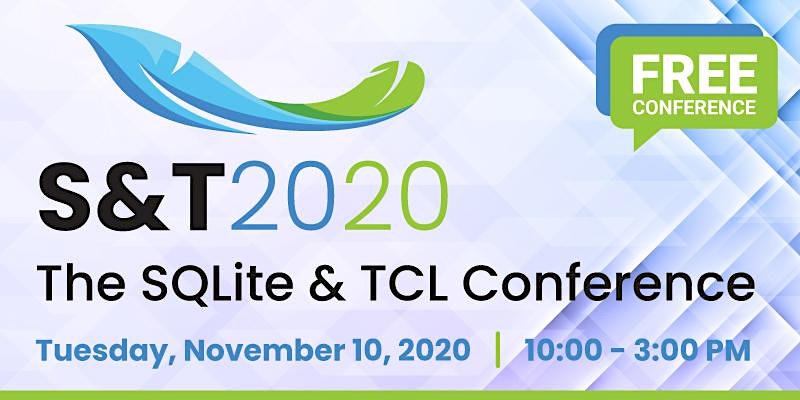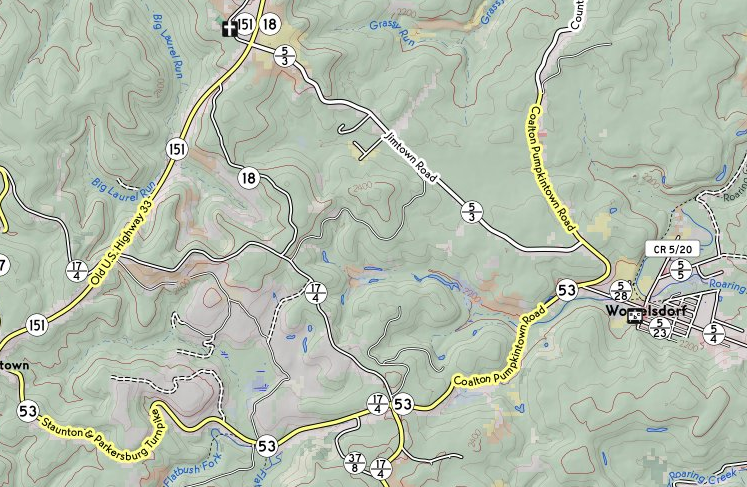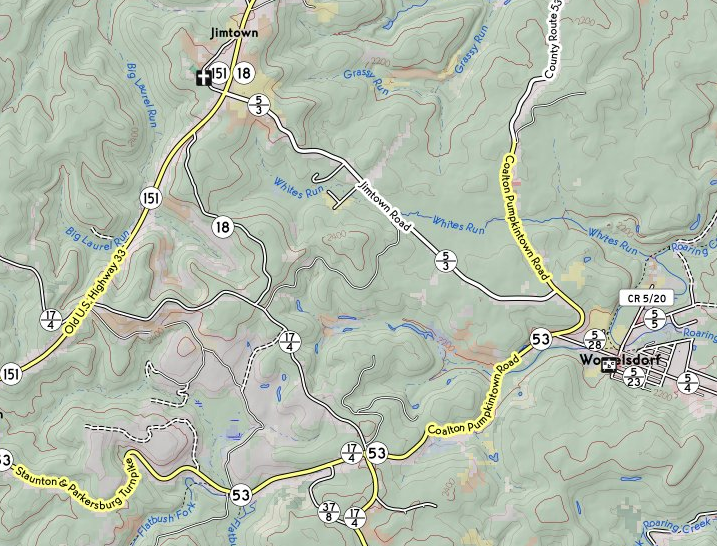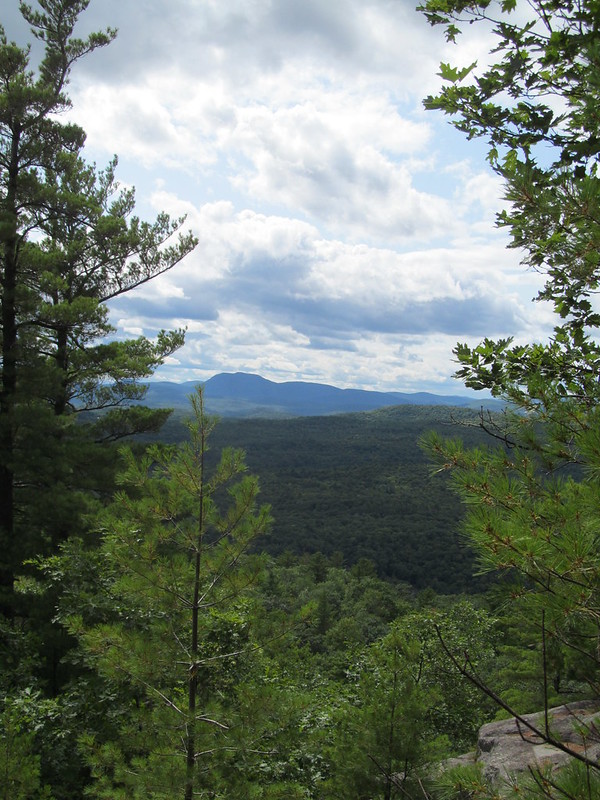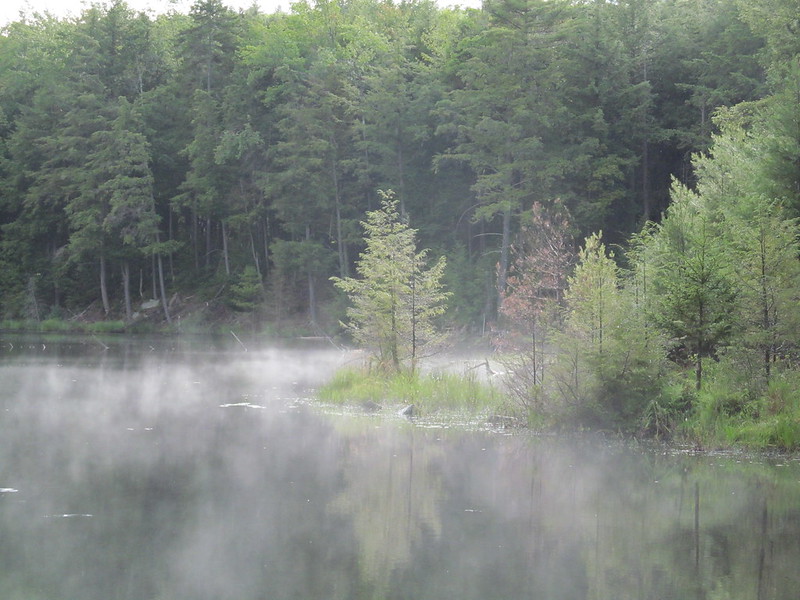On Sunday, September 6, Cathy and I decided to go hiking again -
this time to Eagle and Big Indian Mountains in the Catskills.
She was
particularly eager to do Eagle because for her it was
the one that got away
and we decided that if all went well, we might be up to a second
peak. Big Indian is one mountain over, and you've done 2/3 of the
work of climbing it once you're on the approach trail!
We agreed to meet at 8am, Musician Standard Time (There isn't a
musician who's ever on time for an early morning appointment), got
rolling in good order and were on trail about 10:15.
We headed for the trailhead at Seager, a settlement named for George
Seager, a settler who homesteaded there in 1800. The access road,
Dry Brook Road, winds up a picturesque gorge and passes three
covered bridges on the way in.
There were only two other cars at the trailhead,
bearing decals like
"Winter
35'er" and
"Long Path
End-to-End," so we knew we were in the company of some pretty
awesome hikers. We exchanged pleasantries and started up the couple
of miles of trail that cross Furlow, one of the estates of Gilded
Age robber
baron Jay
Gould, which still belongs to his descendants. The descendants
have graciously given hikers permission to access the trail (as well
as one or two other blazed trails that cross their land
elsewhere). The rest of the large estate is to be considered
strictly off limits.

The trail, an old carriage road, runs along the bank of Dry Brook,
with numerous fords of tributaries and traverses of washouts, some
of which have pretty sketchy footing.
 It's a pretty easy stretch of
trail otherwise. It passes a lovely pool with a waterfall, which
would have tempted us to swim were it not for the fact that it was a
fairly chilly morning and there were obvious signs forbidding
trespassing. (Always respect the landowner!)
It's a pretty easy stretch of
trail otherwise. It passes a lovely pool with a waterfall, which
would have tempted us to swim were it not for the fact that it was a
fairly chilly morning and there were obvious signs forbidding
trespassing. (Always respect the landowner!)
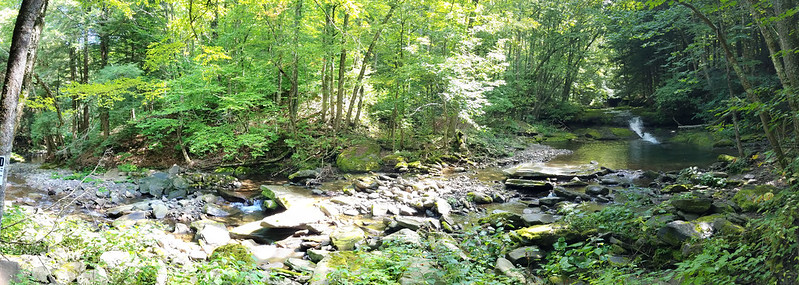
Incidentally, Dry Brook is anything but dry! The origin of its name
is unclear. One speculation is that it was named "Drie Broek" by the
Dutch because it is the third large stream above the Forks of the
Delaware. That sounds a but odd to me: "Derde Kill," or "Derde
Beek," would seem more likely as a name. But I've not heard a more
likely explanation!

In any case, the trail comes to a place where it joins a private
road. It follows the road across the very wet Dry Brook at a
ford. Even in high summer, an SUV must drive through flowing water
there. I'm sure it's completely impassable in snowmelt! Again, the
footing was a bit sketchy, but we managed to cross dryshod.
It was there that we ran into our second party of the day. They
obviously belonged to a different subculture from ours.
“Are you guys heading to Camp 13?”(Never heard of it...)
“No, we're looking for where the trail up to Big Indian leaves the
road. We want to make sure we don't miss it.”
“You need to ask that tall guy in the red cap. He's a real
hiker and knows all the trails.”
Red-capped gentleman: “Oh, you mean up to the ridge? That
trail goes straight up, you know!”
“We'd heard there were a few spots of scrambles.”
“So, are you guys backpacking?”
“No, just here for the day.”
“Daytripping? All the way up there?” He shook his
head. “Good luck!”
We decided not to tell him that we were planning to attack two
mountains. We pretty quickly spotted the trail sign - the turnoff
is not nearly as obscure as others' trip reports had led us to
believe, and continued down a wet trail, now following Shandaken
Brook, fording it back and forth a few times. to the beginning of
the state-owned wilderness and a lean-to.

Up to this point (about 2.5 miles [4 km] in), there's been only
about 400 feet (120 m) of elevation gain. The trail now begins to
climb in earnest, gaining about 900 feet (275 m) more in the next
mile (1.6 km) taking a steep path full of loose rock with
blackberries on one side and nettles on the other. We managed to
avoid taking any bad scratches or stings, although Cathy did take a
bit of a tumble off a rock that was both loose and slick with
algae. She bounced right back up, with the only damage being a
slightly wrenched thumb from a trekking pole strap. She's a trouper!
Once we made it to the col, and started along the ridge for Eagle
Mountain. The trail was level a lot of the time, interspersed with
scrambles up steep ledges. (Everywhere in the Catskills, there's a
scramble at about 3400 feet (anout 1 km) elevation, where a layer of
soft mudstone is overlaid by a layer of much harder conglomerate
rock.)


We negotiated the scrambles, Cathy with more grace than
Kevin, found the turnoff, and arrived at the summit, where I was
surprised to find a canister. I learnt from other hikers that it was
only a year old. We signed in, and had a chat with another party—
relative newcomers to the Catskills—who were backpacking the Pine
Hill-West Branch trail over Big Indian, Eagle, Haynes, Balsam and
Belle Ayre mountains.
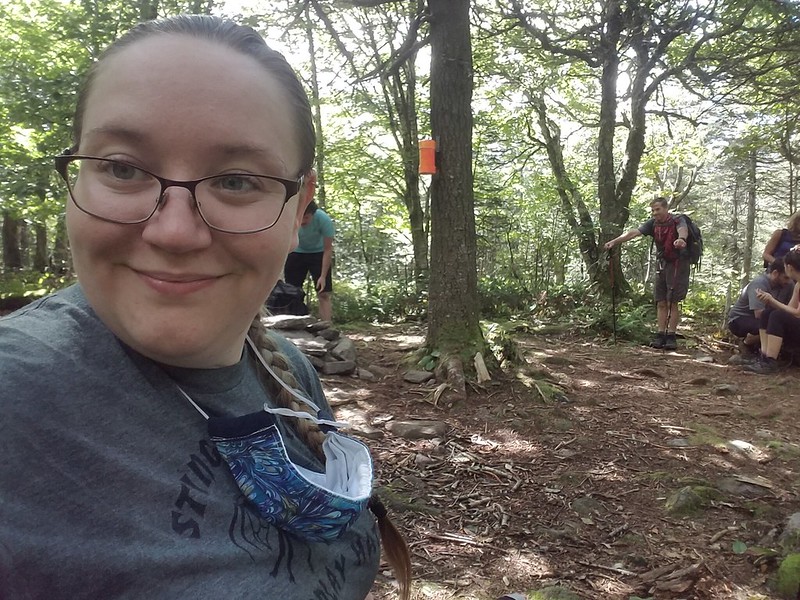
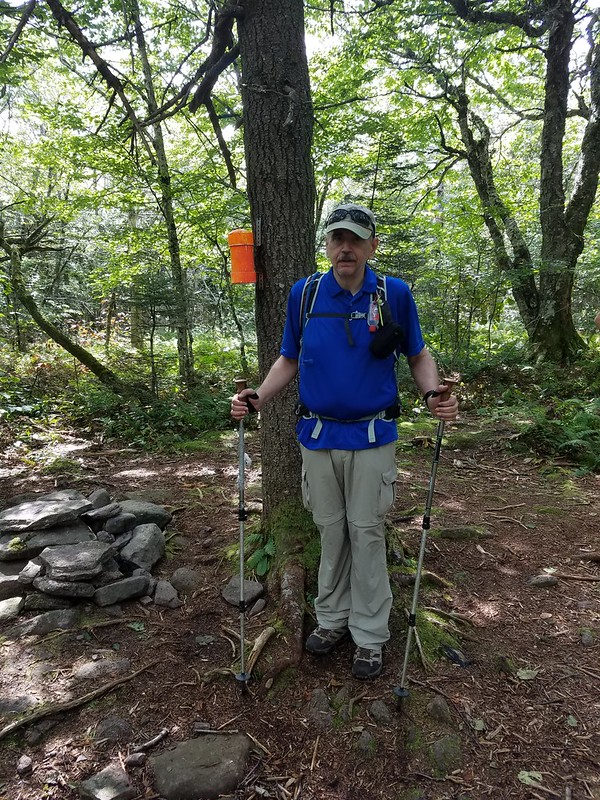
I don't know the origin of the “Eagle Mountain”” name, but
once upon a time, the Catskills were known for having the birds. Herman
Melville wrote [Moby-Dick, chapter 96]:
[...]there is a Catskill eagle in some souls that can alike dive down
into the blackest gorges, and soar out of them again and become
invisible in the sunny spaces. And even if he for ever flies within
the gorge, that gorge is in the mountains; so that even in his
lowest swoop the mountain eagle is still higher than other birds
upon the plain, even though they soar.
I'll think of that as the reason for the name; it might be an
uplifting enough thought to keep me climbing!
While we were eating our own lunch, we were visited by a couple: an
old mountain-man and his mountain-woman. We learnt that she's
completed the Catskill Grid: climbing each of the 35 high peaks in
every month of the year, for a total of 420 ascents. (Not an
achievement that would appeal to me: I like to see new
places!) We wished them well, they wished us luck in finishing the
35, and we headed back for the col.
At the trail junction, we had a strategy conference. It was
mid-afternoon by now, and we had to decide: do we head down, or do
we press on for Big Indian Mountain? We decided that if we still
had enough natural light to take the ford by the private road, we
could hike the remaining couple of miles by headlamp if necessary,
and decided to go for it. (We are not immune to get-there-itis.)
The way up along the ridge to Big Indian was a little longer and
steeper than the one to Eagle, There was more loose rock, more
scrambling, and a few tilting slabs of rock where Cathy was
pleasantly surprised that the soles of her new shoes gripped (so no
need to find better holds). The slabs are obviously a problem in
winter—they were covered with scratches from climbers' crampons
trying to gain purchase.
Along the way, Cathy asked me about the “Big Indian” name. I was
able to tell her that Big Indian Mountain, Big Indian Hollow, and
the village called Big Indian were all named for an extremely tall
native, the subject of a local legend that I couldn't recall. I
looked it up after we got home. The legend appears to be one of the
ones invented out of whole cloth by 19th-century
developers to sell land in their villages.
Winnisook, so the story goes [Charles M. Skinner,
Myths & Legends of Our Own Land.
Philadelphia, Penna.: J.B. Lippincott, 1896, pp. 28-29], was a
seven-foot-tall Algonquin, who fell in love with a Huguenot girl
from the hollow, named Gertrude Molyneux. He asked for her hand, but
her father refused, and insisted she marry a white man, She
conceded, and was married to one Joseph Bundy, who proved to be an
abusive drunk. Believing that she would be happier among the
natives, she eloped with Winnisook. Her family's search for her was
in vain, unto one day Winnisook was sighted leading a cattle-raiding
party. The villagers gave pursuit, with Bundy leading the chase.
Bundy, crying that Winnisook had stolen not only his cattle but also
his wife, fired his rifle. The mortally wounded Winnisook crawled
into the hollow of a pine tree, where the farmers lost sight of
him. Gertrude later found him there, sitting bolt upright, but dead.
The villagers were fond of pointing out the tree, until the construction
of a railroad in the valley removed it. (The railroad itself did not
survive for very many years.)
Since Skinner's book, the story has grown in the telling. Mary Lou
Stapleton, once a shopkeeper in the valley, added the detail that
nobody had been able to extract Winnisook's body from the tree, and
it had grown about him. As she tells the story: ['TravelStorys':
“Catskill Mountain Scenic Byway - Legend of Winnisook”, available
on
SoundCloud],
when the railroad men felled the tree, the skeleton of the Big Indian
fell out, and they said, "well, we have the name of our town now.
It's called Big Indian."
She went on to say,
I used to do events at my store. I would do a little event called,
“Celebration of the Big Indian.” I would have vendors
and I would have drumming. It was the last time that we did it and
it was a lot of people there. I came home and I was just
exhausted. And at three o’clock in the morning I woke up and it was
like someone was calling me. I went back down to the store and I
circle there, and I actually saw a vision. I saw all very, very old
indians dancing in a circle. And they were calling me. So I went in
the circle and I danced for two hours, until 5 in the morning, and
I was with all these native people. And I came back home and I went
to bed. A few months after that, I was given my name, and it was
“Spirit Dancer.” That was pretty amazing… That was
pretty amazing.
Winnisook Lake, and the exclusive Winnisook Club, at the head of the
valley, are also named for the Big Indian.
Whatever the truth of the legends, Cathy and I pressed on, she
unaware of them, and I having forgotten them. When the trail leveled
out near the summit, we started searching for how best to get to the
true summit and the canister. The trip reports we'd read all said
that there was a well-trodden herd path that led from the trail to
the canister. We scouted for it, and found three herd paths leading
east from the trail. The first, and most promising-looking, petered
out after a few hundred feet, at a false summit perhaps a
quarter-mile north of the true one. The second, nearly as
well-trodden, scrambled a ledge and then disappeared.
The third herd path was the least auspicious of the three, but third
time was the charm! We were able to follow it, falling briefly back
on the compass when it occasionally vanished, all the way to the
summit clearing (with a leaf-shrouded hit at a view to the
southeast,) We signed in, took the obligatory selfie, but didn't
hang around. We were going to have to make tracks if we were to have
light for the trip out!

We rushed all the way back on the same trails that we used to get
in, moving so fast that we occasionally noticed ourselves getting
winded and sweaty - on descent! We made excellent time,
arriving back at the trailhead around 7:15, doing the five miles (8 km),
including 1700 feet (about 500 m) of occasionally steep, scrambly, slippery
descent, and many rock-hops over creeks, in about two-and-a-half
hours. Cathy hadn't lit her headlamp at all. My vision in dim light
isn't as good as hers, so I had used mine for the last half-mile or
so, with the Sun having disappeared behind the Dry Brook Ridge and
the trail running in the shadows of a deep pine forest.
Cathy's smart-watch showed us as having hiked 13 miles (21 km) on
the nose, with 2400 feet (730 m) of elevation gain. That's probably
her most strenuous Catskill day yet, and close to being mine! We
scored two new technically-trailless peaks for Cathy, and one new
one for me, bringing my tally to 29/35 + 4/4 in winter—just six
climbs to go to finish the 3500's! Alas, Doubletop is now closed to
me. The owners are allowing only hikers from six neighbouring
mostly-rural counties to climb it, and I don't live in any of the
six. Unless the situation changes,, I'll probably max out at
34/35. Scuttlebutt on the trail is that Doubletop will soon be
closed to hikers altogether—the latest generation of the family is
more protective of the land.


